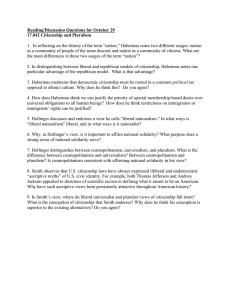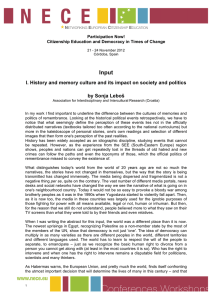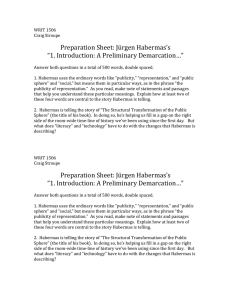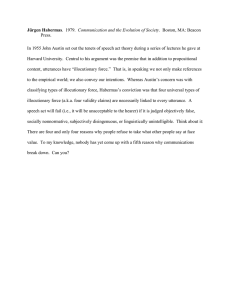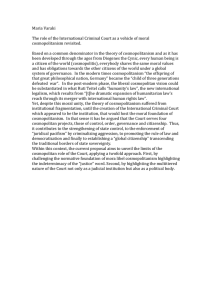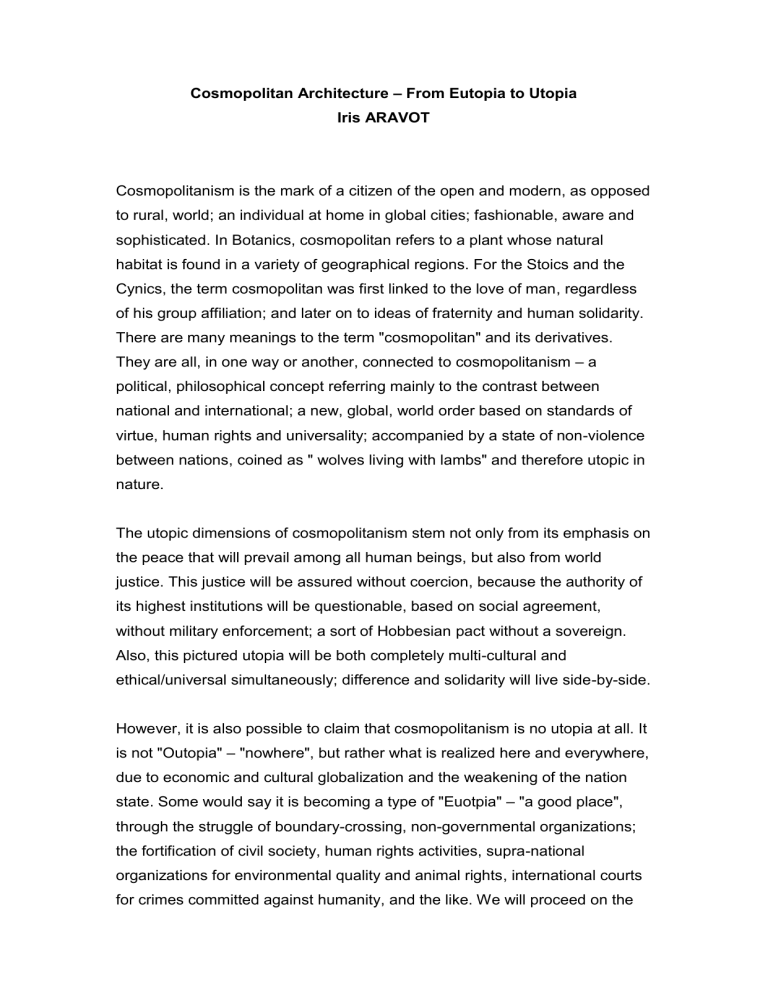
Cosmopolitan Architecture – From Eutopia to Utopia Iris ARAVOT Cosmopolitanism is the mark of a citizen of the open and modern, as opposed to rural, world; an individual at home in global cities; fashionable, aware and sophisticated. In Botanics, cosmopolitan refers to a plant whose natural habitat is found in a variety of geographical regions. For the Stoics and the Cynics, the term cosmopolitan was first linked to the love of man, regardless of his group affiliation; and later on to ideas of fraternity and human solidarity. There are many meanings to the term "cosmopolitan" and its derivatives. They are all, in one way or another, connected to cosmopolitanism – a political, philosophical concept referring mainly to the contrast between national and international; a new, global, world order based on standards of virtue, human rights and universality; accompanied by a state of non-violence between nations, coined as " wolves living with lambs" and therefore utopic in nature. The utopic dimensions of cosmopolitanism stem not only from its emphasis on the peace that will prevail among all human beings, but also from world justice. This justice will be assured without coercion, because the authority of its highest institutions will be questionable, based on social agreement, without military enforcement; a sort of Hobbesian pact without a sovereign. Also, this pictured utopia will be both completely multi-cultural and ethical/universal simultaneously; difference and solidarity will live side-by-side. However, it is also possible to claim that cosmopolitanism is no utopia at all. It is not "Outopia" – "nowhere", but rather what is realized here and everywhere, due to economic and cultural globalization and the weakening of the nation state. Some would say it is becoming a type of "Euotpia" – "a good place", through the struggle of boundary-crossing, non-governmental organizations; the fortification of civil society, human rights activities, supra-national organizations for environmental quality and animal rights, international courts for crimes committed against humanity, and the like. We will proceed on the assumption that the road indeed leads to Eutopia and that, moreover, architecture is always directed at Eutopia. Two Texts The concept of cosmopolitanism has undergone many transformations in new age philosophy and it is not my intention to review them all. Rather, I will focus on two trends of this era that oppose classic, liberal cosmopolitanism and also largely oppose each other: Habermas' "Postnatal Constellation and the Future of Democracy", and Hardt and Negri's last book "Multitude" (2004). The former discusses processes of post-national democracy, while the latter is based on interpretation of accelerating globalization trends that serve the capitalism of multi-national corporations (the "Empire"). Despite the difference in the ideologies and terms of the two texts (and though it may not even be appropriate to compare Habermas with Hardt and Negri) they both share the belief that a cosmopolitan Eutopia can actually be attained through grassroots growth, beginning from the people, the citizens, the masses. A different approach to architecture can be extrapolated from each of the texts, in keeping with their central images: for Habermas, the basic layer for the cultivation of trans-national democracy is composed of communities. For Hardt and Negri, standing up to the "Empire" is possible for a multitude, well organized in networks. Hence, an approach based on Habermas would be directed at architecture of critical regionalism, replete with cultural, universal and local meanings. An approach based on Hardt and Negri could be channeled into numerous architectures, on the condition that they are stripped of symbolism (to prevent entrapment by the Empire). Trans-National Democracy In the eighteenth century, Kant intuited that a pan-human society, based on law is indeed possible, and that the pact between individuals that had beget the sovereign state espoused by Hobbes, is also possible among nationstates themselves. His philosophy paved the way for discussions of the moral principles of liberalistic cosmopolitanism still currently prevalent. The German philosopher, Jurgen Habermas, disagrees with this theoretical/moral stance, and instead observes the actual conditions created in the second half of the twentieth century. It is from these conditions that he ventures into postnational society (associating the term "cosmopolitanism" with theoretical discussion, thus provoking scathing criticism). Habermas claims that market globalization has weakened the nation-states and created problems for democracy at a local level. He believes that citizens perceive representational, democratic processes as peripheral to actual conduct motivated by global forces. The more supra-national organizations determine daily proceedings in society, the less important and less legitimate local political processes become. Habermas' aim in the article (mentioned above) is to investigate the possibility of expanding democracy into a trans-national framework, due to the fact that the nation-state has weakened. The answer to his inquiry is positive: there is no need to cling to national, institutional frameworks to formulate a common perception of the future. The only condition for fashioning this perception is to utilize processes of rational discourse, open to all, ahierarchical and motivated only by educated judgment ("deliberate democracy"). The utopian aspect of this idea emerges in the question of whether or not such a trans-national, democracy, based on adherence to the law, would be strong enough to overcome conflict. Once again, Habermas' answer is positive; it emphasizes the perception of such a future society motivated by a common agenda. Lacking the solidarity enrooted in collective identities of nation states, the "social glue" will stem from a shared value system: moral universality of human rights. Public Space If so, Habermas protests against the outworn political dimension of social life by championing the cultivation of a (deliberate) democratic culture in legal and formal frameworks, as well as in deeper layers of culture, such as education and the family. Habermas does not rely on political, national or international institutions. Rather, he seeks the legitimacy of democratic activity at the most basic level – that of the general public. It is therefore appropriate to proclaim his key concept - "public space". This term was coined by Habermas, with reference to the ideal of free bourgeois discourse, in the 18th century European coffee-shops, that greatly contributed to the establishment of the nation-state. In these coffee-shop conversations, according to Habermas, they discussed and re-discussed issues of political import until arriving at the most convincing opinion. This was accomplished regardless of the speaker's status, and with the willingness to agree to new claims, made on a rational basis. Rational discourse is therefore the basic building block of Habermas' theory, rather than the physical aspect of "public space". Habermas points to the media and to actual physical space as places appropriate for "public space". During the last decade there are those who consider electronic media as the preferable public space for transnational democracy. However for Habermas, though not explicitly stated, democratic discourse as an ideal of communication takes place in an unmediated, face-to-face manner (and here is not the place to criticize this preference). This type of communication takes place between people with sufficient shared norms to facilitate discourse. Therefore, it implicitly assumes physical space, possibly even physical proximity, in the context of a group, whose norm is rational discourse. Without the assumption of shared norms, it would not be public discourse, but merely the organization of interest groups. Without a "body" – there would be no public. The agents of public space are individuals in the full sense of the word: they have a life story, emotions and a physical body. As such, they are stringently required to overcome irrational considerations and abstain from discourse that addresses the emotions (rhetoric). Community Public space is always open to new participants who accept its conditions, while nevertheless maintaining a certain measure of continuity. This continuity is particularly vital in the envisioned trans-national society, which will not be a conglomerate of patriotic feelings, collective heritages or national/historic memories. The cohesiveness of this future society, aside from the value of universal human rights, will be based on the shared agenda of its members. Therefore, its public space cannot be characterized by a total turnover of participants and particularistic norms, from one discussion to the next. Rather, logic and practically dictate the continuity of the group as a group and as a political community; marking this group as a community. The Generosity of a Building and of Public Space As we have stated, public space, according to Habermas, is totally rational, but not virtual, even if it takes place in the electronic media. Its members have equal footing; they can even be anonymous. However, their main interest is their shared agenda and their future lives together. We can assume that the future agenda will include multiple physical manifestations of public space: the neighborhood, the metropolis, the region, and so on. These spaces will be accompanied by various dimensions of time. Hence, the enlistment of architecture to realize the agenda can and must serve not only material and functional needs at different levels, but must also contribute to public aspects for and of the community, by a symbolic expression of identity and values. The narrower the scope of time and space to which the agenda refers, the more its symbolic expression can be authentic and contextual. This requires more openness to usage and to new meanings. The result needn't be banal; the likes of Venturi's decorated shacks, but rather, as lately expressed by Stefano Boeri, the editor of "Domus": "Public building (and space) needs a clear architectural language – an appeal to firmitas; not to pluralism, not to the widest spectrum possibly, but an expression of generosity and openness that can house various activities". Architecture can indeed facilitate generosity and openness of public building and public space. This is not a "flexible", mechanistic, indifferent, noncommittal structure that can fill any functional role or any symbol attached to it. Rather, it is a generosity that allows for "concrete symbolism", of the type that addresses immediate, mundane meanings and renews itself along with the changing community. In addition, and with regard for Habermas' values of post-national society, architecture can and must maintain a "universal symbolism" that expresses overall human values or critiques their lack, in the context of human rights. The Church at Ultimo Garden in Blackwattle Bay, Glebe, Sidney. "Concrete Symbolism". The double pergola and lawn in the middle grow from the horizontal projection of the previous church. The memory is preserved; gathering for traditional religious ceremony is still a definite possibility. Howeveron a sunny winter morning, dogs frolic on the lawn and children climb the columns. Architectural generosity is the expression or contribution of architecture to social solidarity. Human rights can be anchored and protected by law, but solidarity is a feeling; a commitment that remains outside the law. No political community can pass laws guaranteeing solidarity. Solidarity is committed to social justice, but requires a process of structuring by additional, extra-political values. Architectural generosity is one such value – not in the sense of Le Corbusier's "architecture or revolution", nor in the sense of a pivotal moment of subversive democracy. Architectural generosity is not at the epicenter of social revolution. Rather, it is encouraged to make its contribution once the storm has subsided; within the framework of social order, in a renewed structuring of the community, though perhaps shaky and temporary. Architecture cannot cause generosity (or solidarity), but can embody and exemplify its facilitation, not through symbolization, but by its being the specific and local realization of solidarity and openness (or of social critique). Even then, it will always be the bearer of numerous, layered, at times contradictory meanings, according to the functionality of the surrounding environment, landscape, ecology and technology. The National Museum of Australia, Canberra The National Museum of Australia, Canberra, 2001. Architecture: Asthon Raggart MacDougall. "Universal Symbolism" with its numerous layered meanings. http://www.screenact.act.gov.au/locations/national_museum_canberra.html The lightening borrowed from the Jewish Museum in Berlin, planned by Daniel Lebiskind, was meant to symbolize the genocide of the aborigines by Australian settlers. At the same time, the museum is a national museum that, while refraining from formulating identify by adopting a canonic historical narrative, nevertheless promotes the Australian "melting pot" through civil and cultural issues. Sculpture of Maria in the shape of Buddha A sculpture of Maria in the shape of a sitting Buddha in Agoo, Philippines. www.aidan.co.uk/photo843.htm A symbol of tolerance and religious merger or a commercial product used to promote Agoo tourism, or both. Critical Regionalism and Jameson's Criticism If architectural generosity resembles any other familiar architectural theory, it would be that of critical regionalism: locality versus openness to world changes, community versus universality, tradition versus critical thought. The theoretician and historian of architecture Kent Frampton was among the leaders of the idea of critical regionalism in the eighties (20th century). His goal was to create a bridge between architecture and cosmopolitanism. He was not prompted by the potential of creating a utopia, but by the destructive, engulfing and flattening effects of globalization in multi-national capitalism. Frampton espoused critical regionalism in architecture as an opposing strategy; as a means of preventing the sweeping erosion of globalization. Framptom's theory was severely critiqued by Fredric Jameson, a theoretician and influential American Marxist literary critic, who denied the very option of opposing later-day capitalism, which adopts every critical act and turns it into a product. This would hence be the fate of critical regionalism in architecture – to become a "brand name". Frampton positioned local, community-based architecture, with all its complexity and layered values and meanings, materials and technologies, as a dam meant to withstand the billowing waves of globalization. Contrary to Framptom's wide ranging diversity, Jameson's world picture could be curtailed to a dualistic, black and white world picture of power struggles: capitalism and anti-capitalism. This concept is also the basis for Hardt and Negri's book. Empire and the Masses According to Hardt and Negri, the legal regimes of the powerful Western countries, multi-national companies and international institutions, are merely a rising form of global governing – the "Empire" (the name of their previous book) – with one goal: to maintain global capitalism. The "Empire" has a new kind of discontinuous, virtual sovereignty, totally different from modern sovereignty. It establishes new political rights, including military interventions, and makes ideological use of a cosmopolitan utopia, to insure facile activity of the world market. Therefore, Hardt and Negri, similar to Habermas, do not rely on national and international democratic institutions or arrangements. As far as they are concerned, The United Nation Security Council, the Rio Summit, the World Trade Center, and the National Monetary Fund, are no more than a camouflage or a tool serving the "Empire". For them, democracy is not the existing order or the order in need of improvement. Rather, it is unique moments in global networks of agents, who recognize a common situation and join together to engender political change. These are individuals who feel uncomfortable and unaffiliated with the frameworks of the nation-state, and therefore, at certain times, discover a collective that binds them together in joint action. The leading example, for Hardt and Negri, is the anti-global demonstrations in Seattle. Like the "Empire", its opposition is an unprecedented political phenomenon, for which Hardt and Negri have coined a new name: The "Multitude" (the name of their latest book). The global mass is not a democratic community of several billion people. Rather, it is a collection of individuals who persist in their individuality, with the exception of moments of political, anti-capitalist protest. These people do not regularly or usually resemble Hardt and Negri's "Multitude". A "Multitude" is only created when individuality and community connect; when single individuals unite in networks. The networks themselves lack a hierarchic structure and are not supported as "social glue" by regularity, persistence or solidarity. The "Multitude's" activism is not in need of the institutionalized, more orderly side of collective life. On the contrary, it is entirely constructed of atomistic movement (or perhaps "urban nomadism") that, when needed, can form a monument to oppose and resist the "Empire". This idea of joining together to amass power, can be found in Hardt and Negri's work (influenced by Spinoza) as a sort of natural law, i.e. as a principle based on necessity rather than as a mere proposal for action. Symbolism-Free Architecture Every "Empire", i.e. any regularized structure of political power on a world scale (particularly Hardt and Negri's "Empire") needs symbols, including architectural symbols, as tools of dominance and control. It is sufficient to mention the writings of French philosopher and anthropologist, Georges Bataille against architecture, to point out the manipulative nature of architectural symbols and the possibility of hiding their aggressive side, by presenting them as natural. In the current climate of visual display and reliance on technological communication, there is a dangerously close affinity between the public sphere and the advantage taken of this sphere for the needs of the "Empire". For example, it is possible to consider the numerous festivals of consumption, offered again and again, and compare them to the idea of celebration (or revolution, according to the Marxist sociologist and philosopher Henri Lefebvre), as a method of tempting the public into public space. For this reason, symbolism, or, more precisely non-symbolism, is a necessary topic, in the discussion of architecture aimed at cosmopolitanism that opposes the "Empire". However, after modernism, it is no longer possible to offer meaningless architecture. Non-symbolism itself has become a symbolic language, and moreover it has come to represent the idea of internationalism. Another question in the context of cosmopolitan architecture, connected to the issue of symbolization, is its reference to "place". How can it remain specific without bearing local meanings; without becoming easy prey to visual reductionism and commercialism? A possible solution may be adopting a strategy similar to that of the semiologist and literary critic Roland Barthes, who proposed using layering and exaggeration to focus attention on the mythic element of symbols. However, what is appropriate for literature and theater may not necessarily be suited to architecture. Rather than Barthes' method, what is needed is a principle of symbolism that points to its own symbolic nature, thereby preventing the observer from falling into a trap of flattening and neutralization. Cosmopolitan Architecture – From Eutopia to Utopia Ultimately, for cosmopolitan architecture to concur with ideals of a new world order, it will have to make space for the "other". Not merely dualistic others, such as the usual contrasts between black-white, controller-controlled, Western-non Western, male-female, but mainly a new type of "other" that emerges from these contrasting pairs. An approach based on a stable, community-type social structure will present the challenge of generosity or the embodiment of facilitation. Additionally, it will promote symbolism that is both clear enough to constitute "social glue", and loose enough to leave the boundaries of the community open to others. An approach to cosmopolitan networks will posit a symbolism that itself fells its mythic branch, without falling into abstraction. Either way, these challenges are easier to formulate in words than to implement in actual practice. They are therefore Utopian, in the sense of possible realization and Eutopian in the sense of being landmarks on the road to a better world. References Habermas, J. (2001). The postnational constellation and the future of democracy. In M. Pensky (ed.) The postnational constellation: Political essays. Cambridge, MA: MIT Press. Hardt, M. & Negri, A. (2004). Multitude: War and democracy in the age of empire. NY: Penguin Press.
